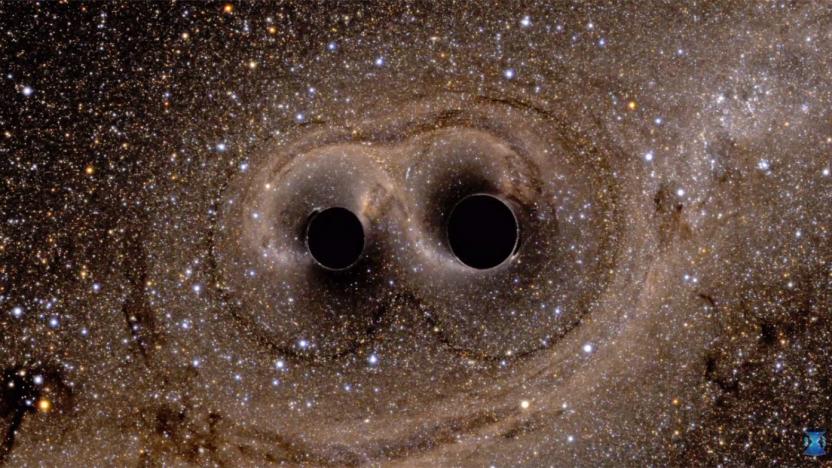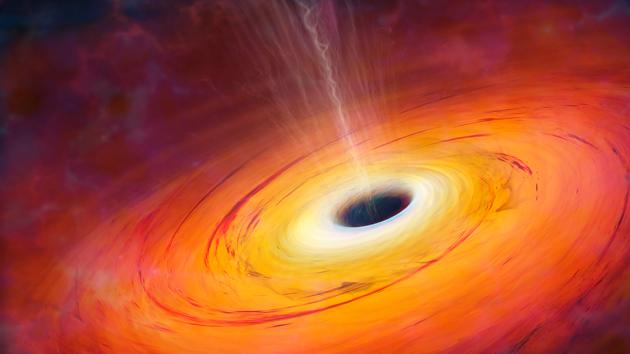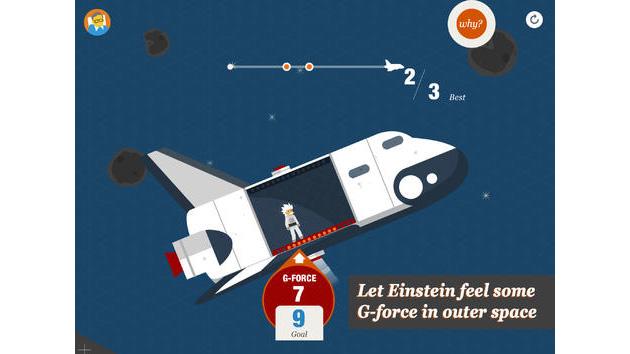astrophysics
Latest

Science confirms that gravitational waves exist
At last, scientists have validated a key part of Einstein's general theory of relativity. The National Science Foundation, Caltech and MIT have confirmed the existence of gravitational waves, or ripples in spacetime. Their two LIGO (Laser Interferometer Gravitational-wave Observatory) detectors measured atomic-scale differences on September 14th, 2015 that point to the collision of black holes (also a new discovery) 1.3 billion years ago, triggering gravity ripples that only just reached Earth. There have long been hints of these waves, but hard evidence has proven elusive until now.

Neil deGrasse Tyson hosts an early Reddit video AMA
Reddit's Ask Me Anything videos are getting off to a very good start. The social site has just posted its first batch of these moving AMAs, and one of these stars none other than Neil deGrasse Tyson, the Hayden Planetarium director known for making astrophysics accessible to everyone. As you might guess, the video format gives deGrasse Tyson the opportunity to answer with the kind of depth and expressiveness that you don't get with a text reply. Among other things, he chooses the universe's best art (spoiler: it's not a painting) and explains why he doesn't like mind-altering substances.

Galaxy studies show that the universe is slowly dying
Not to bum you out, but many scientists believe that the universe will eventually die -- stars and even black holes will release energy until there's virtually nothing left. And unfortunately, there's now stronger evidence that this inexorable decline is real. Scientists using radio telescopes have measured the energy output of 200,000 galaxies with greater precision than ever, and they've determined that these star havens are only producing half as much energy as they were 2 billion years ago. In short, the universe is fading out. This isn't surprising (entropy is inescapable in our understanding of physics), but it does downplay theories that the universe might maintain or even regain energy.

Scientists spot runaway galaxies
It's well established that runaway stars and planets are a cosmic reality, but runaway galaxies? Yes, amazingly enough, those exist. Scientists have discovered at least 11 galaxies moving so quickly (up to 6 million miles per hour) that they're escaping the gravitational tug of their host clusters. Most likely, these wayward celestial bodies are the result of three-way interactions -- a small elliptical galaxy tied to a larger counterpart will fly off into space when another big galaxy gets close enough. It could take a long time before astronomers have a better sense of how common stray galaxies might be, but it's already apparent that the universe is messy at its grandest scale. [Image credit: NASA, ESA and the Hubble Heritage Team]

NASA forms a coalition to look for life on other planets
NASA knows that it can't rely solely on astronomers and robotic rovers to find life on other worlds, so it's recruiting some help. The space agency has formed the Nexus for Exoplanet System Science (NExSS), a coalition of scientists who study astrophysics, Earth, other planets and the Sun. The group will use its collective knowledge to search for alien lifeforms using perspectives that NASA wouldn't always have -- how does the loss of atmospheric chemicals affect the chances for life, for example? NASA hopes that the group will not only determine the habitability of planets, but develop technology to study those planets in greater detail. There's no guarantee that NExSS will discover organisms, let alone organisms that you might see within your lifetime, but the odds of success are now a bit higher. [Image credit: NASA]

Dark matter is (probably) more complex than you think
Scientists typically believe that dark matter, for all of its mystery, behaves in a simple way: if one clump encounters another, the two interact solely through gravity. However, researchers using both Hubble and the Very Large Telescope have published findings which suggest that there's more involved. They've noticed dark matter (the blue lines in this picture) lagging behind a galaxy due to friction, hinting that there are factors beyond gravity at work. It's not certain whether the source of this friction is a familiar phenomenon or something entirely undiscovered, but it's definitely not the usual culprit.

Scientists create dark matter 'map' to see invisible space
We've finally gotten our first glimpse at the mysterious material that supposedly makes up 27 percent of the universe. It's only taken two years of research, the efforts of 300 researchers working for the Dark Energy Survey (DES) and a 570-megapixel camera attached to the Victor Blanco telescope in Chile to do so. Their findings, in the form of a map, are expected to be released at a meeting of the American Physical Society tomorrow. Well, "map" is a bit of a misnomer dark energy can only be observed indirectly, through the lensing effect that it has on stars and galaxies.

Supernovae suggest the universe is growing slower than expected
Don't look now, but what you know about the universe's growth might have been turned on its ear. University of Arizona scientists have learned that a certain type of supernova (Ia) isn't the reliable measuring stick for universe expansion that previous data would suggest. By comparing optical and ultraviolet images (such as in the hybrid image you see above), they found that older, farther exploding stars aren't behaving in the same way as newer ones closer to our own star. In other words, the ancient supernovae aren't necessarily as distant as you'd think -- and if they aren't, the universe isn't growing as quickly as textbooks say.

The building blocks of life found orbiting another star
Looks like NASA's Chief Scientist Ellen Stofan may have over-estimated how long it would take to find extraterrestrial organisms. For the first time in the history of astronomy, scientists have discovered two complex organic molecules, which is vital to the formation of life as we know it, outside of our solar system. Researchers at the Harvard-Smithsonian Center for Astrophysics in Cambridge, Massachusetts actually found three forms of cyanide -- specifically hydrogen cyanide (HCN), methyl cyanide (CH3CN), and cyanoacetylene (HC3N) -- circling a star known as MWC 480. These are the same sorts of chemicals (and in the same concentrations!) that were present in comets orbiting our own solar system back when life here got its start. And while cyanide is super-duper toxic to living organisms, it's absolutely necessary for life's formation. In short, this discovery is a huge deal because it means that the seeds of life aren't confined to Sol alone.

The Milky Way galaxy is full of ripples (and larger than you think)
When you picture the Milky Way galaxy, you probably imagine a relatively flat disc. Well, you may have to get that image out of your head -- astrophysicists have determined that the galaxy has at least four "ripples," making it look more like a piece of corrugated cardboard than a gentle circle. Those three-dimensional shapes hint that the Milky Way is not only more complex than previously thought, but about 50 percent larger... and that's assuming there aren't hidden ripples extending the range even further. While there haven't been studies of the whole galaxy yet, the findings suggest that there's a lot left to discover about these gigantic star clusters.

The Big Picture: A far-away supernova split into four
Gravity can play a lot of tricks with light, and we're not just talking about black holes. Take this recent Hubble Space Telescope discovery from UC Berkeley's Patrick Kelly, for example: those four lights are actually a distant supernova magnified and split into four images by the gravitational lensing of a giant galaxy. Besides looking cool, the image promises to be a gold mine for astrophysics. The time delay between those four lights will let researchers study both the properties of the exploding star and the galaxy, including the presence of dark matter. The best part? Due to the light's unusual path, there's a good chance that scientists will get a "rerun" in a few years if they want to see it again. [Image credit: NASA/ESA/FrontierSN/GLASS/Frontier Fields]

The black hole imagery of 'Interstellar' is helping astrophysics
You may have heard that the representation of a black hole in Interstellar was not only based on real science, but might tackle researchers' problems depicting these gravitational points. Well, that just happened -- physicist Kip Thorne and visual effects outfit Double Negative have published papers detailing the code used to portray the movie's black hole, Gargantua. Rather than trace individual light rays, they followed the paths and shapes of the millions of distorted beams traveling around the hole. The technique eliminates flickering effects that not only wreck your moviegoing experience, but prevent astrophysicists from getting a clear picture of what such a scene would look like in real life.

We're (eventually) doomed: passing stars may rain comets on Earth
There are many things in space that can bring life on Earth to an end, whether they're wayward asteroids or the eventual death of our Sun. However, the chances of a calamitous event may well go up if the calculations of Max Planck Institute scientist Coryn Bailer-Jones are on the mark. He estimates that two orange dwarf stars, GL 710 and Hip 86505, could start messing with comet orbits as they approach our solar system. If they get close enough, their gravitational pull would send a torrent of comets our way and greatly increase the likelihood of an Earth-shattering kaboom.

Researcher finds a way to mimic curves in space-time
Here on Earth, it's rather difficult to replicate curved space-time -- to get that kind of effect in nature, you'd have to get uncomfortably close to black holes and other distant space objects. However, researcher Nikodem Szpak may have found a way to simulate that bend without facing oblivion. His proposed technique puts supercooled atoms in an optical lattice created by a laser field; so long as the laws of quantum mechanics and thermodynamics hold true, the atoms should behave like they're experiencing curved space-time. You can even change the lattice's pattern to mimic different circumstances, whether it's a moment right after the Big Bang or the surface of a star.

Cosmic dust definitely clouded Big Bang researchers' findings
Earlier this year, researchers at the Harvard-Smithsonian Center for Astrophysics and the BICEP2 telescope in Antarctica were thought to have found evidence of gravitational waves produced during the first moments of the big bang. The discovery was heralded as one of the most important discoveries of our era -- unfortunately, the results were contaminated. While going through peer-review, astronomers began to wonder if cosmic dust may have skewed the results. Now the verdict is in: it did, but that doesn't necessarily mean the theory is false.

Big Bang researchers aren't so sure they have proof of cosmic ripples
Remember that evidence of the early gravitational waves formed by the Big Bang? Apparently, it's not as surefire as scientists once thought. The newly peer-reviewed findings note that there's "unquantifiable uncertainty" in the source data; cosmic dust in the astronomers' map of the universe may have skewed the results. More recent mapping efforts also suggest that there might have been a false signal.

Telescopes spot an explosion that took place just after the Big Bang
Space is vast. So vast, in fact, that if a sun exploded shortly after the Big Bang, the light from the fire would have only brushed the Earth's surface in the last few months. One such gamma-ray burst, believed to be 12.1 billion years old, was detected by Southern Methodist University in Dallas on April 19th. Since astronomers don't know much about the shape or structure of the early universe, data from the burst will be trawled in order to glean more facts about where we all came from. In many ways, it's a bit like getting a telegram from a long-deceased relative about buried treasure, except it's nothing like that. [Image credit: Southern Methodist University]

Scientists find a way to create matter from light
Scientists have long theorized that you can create matter from light by colliding photons, but proving that theory has been a different story -- you need the right high-energy particles to even think of trying. However, it looks like that once-impossible dream is close to becoming reality. Researchers at Imperial College London have discovered a technique that should produce electrons and positrons by colliding two sets of super-energetic photons. To create the first batch of photons, you have to first blast electrons with a laser, and then shoot them at a piece of gold; you produce the other batch by firing a laser at the inside of a small gold can to produce a thermal radiation field. If you collide the two photon sources inside the can, you should see electrons and positrons spilling out.

Astronomers find evidence of cosmic inflation, gravitational waves and the Big Bang
In the immediate aftermath of the Big Bang it's believed the universe grew at an exponential rate in what is known as cosmic inflation. Well, the first solid evidence of this growth, which would explain the uniform structure of the universe, has been discovered in the form of a curl in the cosmic background radiation left by the Big Bang itself. The "curl," known as B-mode polarization, is believed to be caused by gravitational waves produced during the first fractions of a second of existence. As it expanded and nothingness filled with extremely high-energy particles, waves of gravitational forces would have propagated, not unlike ripples on a pond, leaving behind scars.

Stephen Hawking's first official app teaches the basics of the universe
Stephen Hawking has gone to great lengths to promote science through books and videos, but he has been conspicuously absent in the software world -- until now, that is. The astrophysicist has just teamed up with Random House on Snapshots of the Universe, his first official app. The $5 iPad title teaches the fundamentals of space through mini games: players learn about G-force with Einstein, put planets into orbit and come to grips with the theory of relativity. Particularly curious users can go deeper with both video explanations from Hawking as well as old-fashioned text. Snapshots is no substitute for reading A Brief History of Time, but it may inspire young scientists to learn more.




